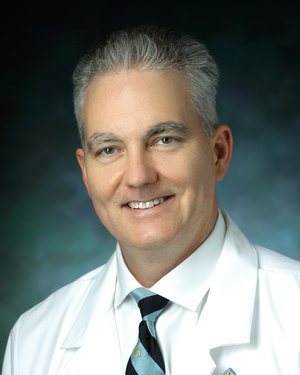

Can moving their heads from side to side or up and down help astronauts more quickly readjust to gravity upon their return from space? That’s the goal of new research being conducted by investigators at Johns Hopkins, the National Aeronautics and Space Administration (NASA) and the U.S. Navy.
Many astronauts experience issues such as spatial disorientation and vertigo when returning to gravity, explains vestibular disorders expert Michael Schubert, a professor in the departments of otolaryngology–head and neck surgery and of physical medicine and rehabilitation. “They have illusory senses of movement where they know they’re not moving but they feel as if they are,” he says. This can impact people’s physical movements and ability to navigate their environment, or control or exit a capsule or vehicle.
Schubert; Associate Professor of Otolaryngology–Head and Neck Surgery Matthew Stewart; and colleagues are part of a team that developed a self-administered vestibular rehabilitation tool to see if following a protocol of certain head movements can help people recover more quickly. The team is testing the idea, which piggybacks off informal feedback NASA received from some astronauts returning from space, who reported better readjustment if they moved their head when re-entering gravity.
“Our research is really trying to stop that motion sickness and preserve their spatial awareness and ability to move through their environment and also control vehicles and different equipment that they need to,” Schubert says.

In a clinical trial, investigators are testing the tool in two populations: 24 active duty military service members who are of similar age and size to astronauts, and 24 civilian patients who have had tumors removed from their balance nerve.
The military participants, who will be tested at Wright-Patterson Air Force Base in Dayton, Ohio, will spend 60 minutes in a machine developed by the Navy called the Kraken that can be configured to replicate different flight motions to disorient its occupants. Following the ride, half of the participants will follow the head-movement protocol for 15 minutes while wearing video goggles to track their head and eye movements. Then, they’ll be sent to perform some physical tasks like standing on foam with their eyes open and closed, and completing a standing and walking test that includes stepping over an obstacle. The remaining participants will proceed straight to the physical test without the head-movement exercises.
The civilian patients, to be tested at Johns Hopkins, will follow a similar pattern, with half trying the head-movement protocol prior to completing the same physical challenges, and half completing the challenges without the protocol.

One goal is to ensure the program can be used independently, as there can be a communication delay from the space station or shuttles to experts on the ground during longer space missions, Schubert says. Others are to show that the protocol can reduce motion sickness and improve posture and gait, returning people to typical physical performance.
Pull quote: “Our research is really trying to stop astronauts’ motion sickness and preserve their spatial awareness, as well as their ability to move through their environment, while also controlling vehicles and equipment.—Michael Schubert
To learn more about the Kraken, See Video

